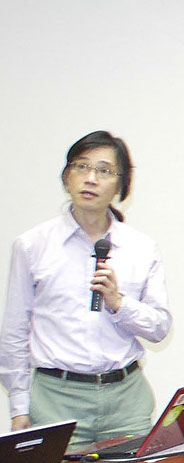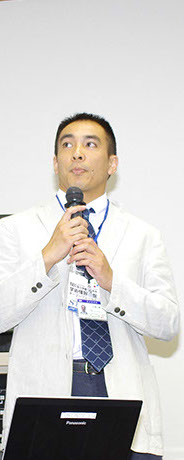
NII Goes Open
Open Access: Who Is Going to Deal with Gold OAs?
by Yukino Aihara, Scholarly and Academic Information Division, NII
Ms Aihara talked about a survey on the current usage of OA journals conducted by SPARC (Scholarly Publishing and Academic Resources Coalition) Japan. To begin with, she clarified the definition of ‘Gold OA’ as follows: 1) Gold OA is the Open Access Journals that have peer reviews; and 2) Gold OA requires APC (Article Processing Charge). Currently, there is no fixed translation for APC in Japan. In this presentation, it is referred to as a fee charged to an author who has submitted an article to OA journals.
There are three questions to be asked in order to investigate the current usage of APC in Japan: 1) How is it paid?; 2) How much is paid?; and 3) Who knows about the payments? With these in mind, SPARC Japan conducted a series of surveys in 2013 (herein after referred to as APC Survey), and recently published the results on the web (www.nii.ac.jp/sparc/2014/05/apcwgreporth26.html). The web-based survey was conducted with researchers (2475 valid responses). Interviews were also conducted with 8 academic research institutions. The information was collected using 5 overseas associated articles. The questions to researchers included: 1) What are the factors for choosing journals for publishing papers?; 2) How many papers have they submitted to OA journals?; 3) What are the factors for choosing OA journals for publishing papers?; 4) How much have they paid for APC?; and 5) Where does the money come from? The questions to institutions included: 1) Do they know about APC payments made by their academics?; 2) Where does the money come from to make these payments?; 3) To what extent are their academics aware of APC?; and 4) What is the institution’s policy on publishing research results, and how do they rate OA journals in that context?
The findings from the questionnaire survey to researchers were as follows. The top reasons for choosing journals were: the credibility of the journal in the specific field of study; and the compatibility of the journal’s specialism with their own paper. Being an OA journal was listed at the bottom, which indicates that it is not an important factor for choosing journals. Out of 2,475 valid responses, 1,602 respondents answered that they did not publish a paper in OA journals at all within the last one year. 461 respondents answered that they published one paper in an OA journal. The total cost spent on APC within the last one year was on average 166,433 yen with a median value of 135,000 yen (among 522 valid responses). The findings from the interview surveys can be summarised as follows: institutions acknowledge the importance of knowing the total amount spent on journal subscriptions including APC payments; however, few institutions understand the reality of APC payments within the institution. The issues that were revealed by the APC Survey were: it is necessary to start thinking about creating an institutional model and appropriate price settings; and it is important for institutions to consider how to manage academic resources including OA journals and how to reinforce the dissemination of research results.
Aihara concluded the presentation by answering the title question: Who is going to deal with Gold OAs? Depending on the scale of an institution, there will be different parties that may be involved in dealing with Gold OA. This could be a library, research supporting division, researchers, or URA. She argued that it is necessary for all the relevant parties to work together by offering their strengths and to deal with publishers as a whole. As libraries have experience of directly negotiating with publishers through the subscription contract, they can play an important role. JUSTICE will continue to gather data and information to better understand the situation around APC and provide support not only for libraries but for all parties that may deal with OA publishers.

Towards the Development of a System for Disseminating Knowledge
by Shigeki Sugita, Chiba University Library
The Institutional Repositories Promotion Committee was established in 2013 by the collaboration of Japan Association of National University Libraries (JANUL) and NII. Its mission is to facilitate the promotion of institutional repositories. As a member of the recently established committee, Mr Sugita outlined the current situation of institutional repositories in Japan; the committee’s future vision and strategies; and how the committee is planning to build a system which allows universities to disseminate knowledge through their institutional repositories.
In the last 10 years, the number of institutional repositories has dramatically increased and there are 394 institutional repositories (about 500 including the ones currently under construction) throughout Japan. However, it cannot be denied that these institutional repositories have not contributed to the promotion of open access. For example, it is said that only 3~4% of all papers written by academics in an institution are put into their repositories.
The committee’s future vision is to facilitate institutional repositories to become a centre of university information infrastructure by accumulating research results and making them available through open access. In order to achieve this, the committee and university libraries (i.e. administrators of institutional repositories) must work together with the following four strategies in mind: 1) To create a policy on open access and implement it; 2) To upgrade the infrastructure for the future institutional repositories; 3) To enhance content and utilise it; and 4) to train and nurture human resources.
First, the committee will support universities to create an open access policy by producing guidelines for how to make research results public, and enhance research infrastructure, diversify content, etc. As an example, Sugita introduced the European Commission’s HORIZON 2020. This is a plan to promote academic research and innovation in Europe with 80 billion euro of funding. The research results from this project are planned to be made available via open access. He argued that Japan also needs to expand content and improve the infrastructure that supports the usage of such content.
Second, the committee will upgrade the infrastructure for institutional repositories. JAIRO Cloud is NII’s award winning (*1) system on which institutions can create and run their own institutional repository (*1: JAIRO Cloud won Stanford Prize for Innovation in Research Libraries in 2013). Sugita asked for the cooperation of university libraries to improve the JAIRO Cloud. There must be a lot that they can contribute from their experience of building their knowledge.
Third, the committee will expand content by sorting out unfiled content and promote diversified use by research communities. It is particularly important for a repository to collaborate with a research group from the beginning of a project, accumulate the results as it progresses, and publish them as comprehensive data.
Finally, the committee will engage in the training of professionals. In the management of a repository, librarians are required to deal with non-paper based digital content that they may not have dealt with in the past. The committee will also encourage the exchange of information and international cooperation. For example, the committee will participate in international networks such as the Aligning Repositories Networks and actively make contribution to the modification of policies and standardisation of technology and services.
As the committee is still young, it has to start with gathering people and creating working groups. Then, it will promote the plan by delegating each piece of work to working groups. Sugita concluded his presentation by calling for active participation from librarians.

Open Data: The Possibility of Creating Data Repositories in Japan
by Hideaki Takeda, Professor, NII
Prof. Takeda outlined the current trend of publishing data for its own sake and digitising papers and the movement to denominate digital identifiers to different aspects of research such as papers, data, researchers etc. Then, he showed potential designs of constructing Data Repositories in Japan by identifying its advantages and disadvantages and pointed out the issues that need to be addressed. He concluded his presentation by suggesting how we could move towards the creation of a Data Repositories in Japan.
In the past, research data were simply material for writing up a paper and kept only for the use of the researcher. In recent years, however, research data has come to be seen as one of the research results being published together with papers. Data can also be treated as the subject of research. Therefore, in the near future, a paper and associated data will become integrated and research will become a supply chain of data. In other words, data can be regarded as research results in two ways: 1) research data are published as research results (e.g. a paper will be published with data attached, or data itself is published as it is such as in ‘Data Paper’); and 2) papers are turn into data (i.e. large amounts of articles will be processed to become digitally readable).
First, why do researchers need to publish data? For one thing, there are demands from society for: 1) sharing research results with a wider audience; and 2) making data public property in the case of publicly funded projects. Also, publishing data facilitates an open research community: 1) for the development of future research; and 2) for assuring reproducibility. In terms of reproducibility, there are categories of science that are difficult to reproduce: namely, simulation science, which is called the ‘third science’; and data-oriented science, which is the ‘fourth science’. The papers of these types of science are not the ‘results’ but rather the ‘introduction’ of research. Therefore, the only way to publish the results of such research is to publish programs, processes (workflow), and data. In this way, publishing data is a hot topic in the world of research. For example, an international consortium, Research Data Alliance (RDA), was established last year in order to build an international infrastructure for sharing research data. The number of Data Papers is increasing and there are websites such as Ecological Research that made data searchable and downloadable.
The second point was that of papers turning into data. In other words, papers are processed to be readable by computers. In order to turn papers into usable data, they are evaluated by paper databases such as Citation Index or, more recently, Altmetrics. For the effective digitalisation of research results, different types of IDs are denominated to different categories of research (e.g. DOI for papers, ORCID is researchers, FundRef for funding institutions, and Linked Open Data). In this way, the publication of data is being promoted alongside the development of a common data infrastructure.
DOI (Digital Object Identifier) is a service run by the International DOI Foundation (IDF), which started as a system for sharing the same identifier among publishers. The merits of DOI are that it allows sustainable and consistent services of digital objects. CrossRef, which is part of DOI, is denominated to papers by publishers. Having citation data allows them to manage papers appropriately. Recently, Japan Link Center (JaLC) was established and is due to start issuing DOI to Japanese resources. As one of the initial projects, they will start denominating DOI to content stored in institutional repositories. JaLC is also a member of the Europe initiated project, DataCite, which denominates DOI to data (e.g. scientific data). JaLC is planning to issue DOI to Japanese data through cooperation with DataCite and is currently considering a pilot project. Examples of denominating DOI to data can be seen in a figure sharing site, figshare, which allows users to upload their figures and denominate DOI (i.e. figshare is a member of DataCite and thus can denominate DOI). ORCID (Open Researcher and Contributor Identifier) is an identifier used to denominate individual researchers. ORCID was created in 2011 and has been increasingly used by researchers, institutions and publishers.
Takeda argued that Data Repositories in Japan must be considered within the context of such trends. Three possible designs can be considered for Data Repositories in Japan: 1) an upgraded version of institutional repositories; 2) an upgraded version of data catalogue; and 3) field-specific sites. The advantages of the first design are that researchers can use the system they are familiar with and researchers can use it comprehensively together with papers. The disadvantages are that the large amounts of data cannot be stored and that there are differences in metadata between data and papers. The advantages of the second design are that there is existing software and that it can collaborate with open data sites. The disadvantages are that it is not linked to institutional repositories and that it is not compatible with various IDs unique to academic data. The advantages of the third design are that it is feasible to utilise existing field-specific repositories as they already have data storage, access, and metadata data that are specific to each field. The disadvantages are that metadata is not compatible and that they use their own software.
The issues that need to be addressed can be summarised as follows: 1) Who will be in charge of it within an institution (e.g. library, computing centre, management section)?; 2) Who will be in charge of it as an overall leader (e.g. NII, JST, JSPS, MEXT, NICT)?; and 3) What kind of data should be included (e.g. size, format, frequency of updating, metadata, usage restriction)? Based on these, Takeda suggested that we should start small by starting from institutional repositories and by utilising existing systems such as denomination of DOI through JaLC and DataCite. At the same time, he argued that, we should also have a big picture by holding meetings with relevant parties.

Open Education: Libraries that Support Active Learning
by Shin Kataoka, Scholarly and Academic Information Division, NII
Open Education is a new form of education and the concept for universities to make their educational resources widely available on the web. Mr Kataoka outlined the current situation surrounding open education in Japan and what kind of publication channels exist, and discussed how university libraries can facilitate this by showing an example of Kyushu University Library.
Kataoka first raised the issue of managing open education resources. It is usually the library’s job to manage resources such as books, journals, e-books, e-journals, digital repository, and digital archives; however, when it comes to e-learning materials, research data and research funding data, it is not so clear who is in charge and whether there is a systemised method to manage them. The open education resources are usually referred as Open Education Resources (CER) or Open Textbooks and are made available via publication channels such as Open Courseware (OCW) and JOCW and commercial channels such as iTunes U and YouTube.
Currently, Japanese universities are publishing their education resources by creating an account on YouTube or iTunes U. In some cases, OCW/JOCW is used: For example, Open University of Japan and NII are collaborating to run a pilot site, GLOBEreferatory.jp, on GLOBE (Global Learning Object Brokered Exchange) using WEKO system. Kataoka showed how data are registered on each site (i.e. YouTube, iTunes U and GLOBEreferatory.jp). For example, YouTube’s administrator’s site has a detailed settings page where one can register categories (e.g. science, technology), age restrictions, distribution options, etc. iTune U has a registration page for metadata (RSS). GLOBEreferatory.jp links to each institution’s OCW and uploads the resources directory.
Kataoka pointed out that the issue of open education resources is that the data is not systematically managed within an institution and it is left to the individual administrator’s discretion in many cases. In such cases, when an administrator has changed or left, no one knows which content was published on which channel. Therefore, there needs to be a better management system. He introduced Kyushu University Library as an example of managing open education resources appropriately and efficiently.
Kyushu University Library manages various types of metadata such as catalogue, institutional repository, research, digital archive and e-learning materials in an integrated manner with a single system. Therefore, they can supply data uniformly to various search services such as discovery tools (for overseas papers), internal search service (for Kyushu University’s collection), and outside sites (e.g. JAIRO). On their browser, different resources are categories by topics (e.g. book/journal collection, research products, theses, etc) and navigated by each icon. All resources are searchable from the library’s browser. On the management page, an administrator can set the definition of each schema (field) by each data set. For example, if it is the institutional repository, there will be title, author, issue number, etc. E-learning dataset is their new addition and has common categories such as title, author, etc as well as e-learning specific fields such as target department, subject, date of recording, etc.
Kataoka argued that university libraries are in the best position to manage open education resources appropriately because libraries already have expertises that can be easily applied. For example, the method of managing data is very similar to that of DSpace or JAIRO Cloud, which librarians are familiar with. Library professionals have valuable experience of handling data through cataloguing including describing information according to rules, indicating the source (quoting), and sharing resources. Libraries also have a sustainable foundation that can carry out a new operation continuously. He suggested that NII and university libraries work together toward the integration of three ‘Os’: Open Access, Open Education and Open Data. Kataoka concluded his presentation by calling for the collaboration of library professionals to realise a better academic infrastructure for the future.


